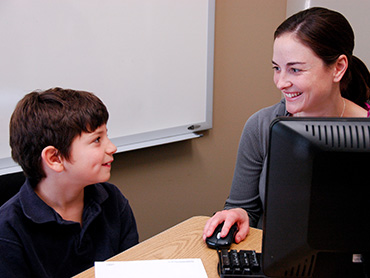 The most rewarding part of a Read Naturally intervention—for both students and teachers—is the progress students make. By this point in the school year, you likely have several students who have made significant gains in fluency, comprehension, or both. When you notice this growth, it’s time to assess whether the student needs an extra challenge in the form of a goal or level increase. Typically, you’ll make such a change after a student has completed 12 stories at his/her current level. Here are the signs it’s time to raise the goal or level:
The most rewarding part of a Read Naturally intervention—for both students and teachers—is the progress students make. By this point in the school year, you likely have several students who have made significant gains in fluency, comprehension, or both. When you notice this growth, it’s time to assess whether the student needs an extra challenge in the form of a goal or level increase. Typically, you’ll make such a change after a student has completed 12 stories at his/her current level. Here are the signs it’s time to raise the goal or level:
- The student's cold- and hot-timing scores have improved significantly.
- The number of practices it takes for the student to reach his/her goal has decreased significantly. If a student typically reaches the goal in fewer than three practices, this is a strong indication that it is time for a change.
- The student consistently exceeds his/her goal on the hot timing.
- The student's behavior indicates the student is no longer challenged. For example, the student may appear bored.
Determine which element to raise—goal or level—by considering the gains the student needs to make in order to achieve his/her long-term fluency goal of reading unpracticed, grade-level material at a rate that is at least at the 50th percentile of national norms. When deciding whether to raise the goal or the level, note the following recommendations:
- If the student's Read Naturally level is several years below grade level and the student has completed at least 12 stories in his/her current level, raise the level.
- If the student's Read Naturally level is close to grade level and the average cold-timing score is close to or exceeds the goal, raise the goal.
- If the student's Read Naturally level is close to grade level and the average hot-timing score exceeds the goal by more than ten, raise the goal.
Once you've decided which element to raise—level or goal—follow these guidelines to help ensure the student's continued success:
- Raise only one element at a time: either the level or the goal.
- Raise levels by half a year if materials are available (upper levels do not have half-year increments).
- Raise goals by 10 words at a time.
- Discuss the change with the student, asking for his/her input.
Please note that gains in rate or comprehension most often signal the need for a goal change, not a level change. One thing we frequently notice in our Read Live data analysis is that level changes occur when a goal change would be more appropriate. Most students need to complete the whole level of material to solidify their gains before tackling the harder reading material in the next level. If you’re considering raising the student’s level, first ask yourself if a goal change will suffice in providing the extra challenge your student needs.
Our website contains lots of additional information on monitoring student performance in Read Live and monitoring student performance in Encore. If you have further questions about how to adjust your students’ goals and levels, please contact us. We’d love to support you in making decisions that will optimize your students’ progress.
 Share your student’s success story—nominate him or her for our Star of the Month award. Win a Barnes & Noble gift card for the student and a Read Naturally gift certificate for your class!
Share your student’s success story—nominate him or her for our Star of the Month award. Win a Barnes & Noble gift card for the student and a Read Naturally gift certificate for your class!
Post a New Comment